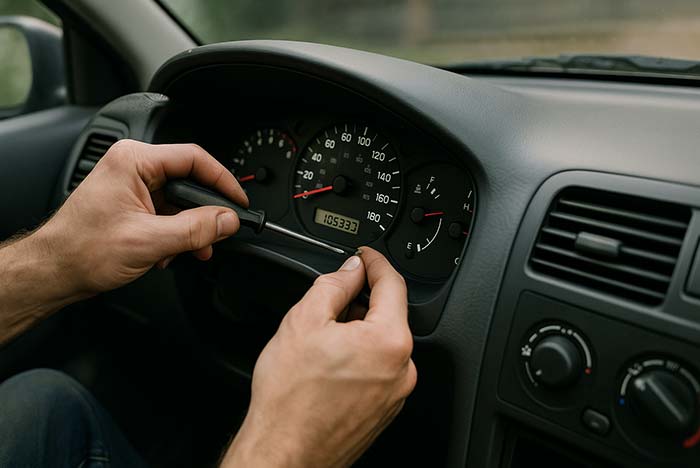
How to Detect Odometer Rollback – Spot Tampering & Verify Mileage
How to Detect Odometer Rollback – Spot Tampering & Verify Mileage
Buying a used car always comes with some risk. One of the biggest is odometer rollback.
This type of fraud makes a car look like it has fewer miles than it really does. That means you could overpay for a worn-out vehicle—and miss key maintenance issues that come with higher mileage.
With digital dashboards now common, many think tampering is no longer possible. But it still happens. In fact, digital odometers can be hacked using tools that reprogram the system. And without knowing how to detect odometer rollback, you might not even notice.
This guide explains how to spot the signs, check mileage online, and even get a certified odometer reading. We’ll also cover what to do if you suspect tampering, and what penalties exist for sellers who roll back odometers.
Whether you're buying or selling, knowing the truth about a car’s mileage matters. Let’s look at how to find it.
Would you like me to expand the first main section: What Is Odometer Rollback and Why It Happens?
What Is Odometer Rollback and Why It Happens
Odometer rollback is when someone changes the mileage reading on a car to show fewer miles than it has actually driven. It's one of the most common types of car fraud—and it's illegal.
Why Roll Back the Odometer?
Mileage is a key factor in a car’s value. Lower miles mean a higher resale price. Sellers roll back odometers to:
✨ Make old cars look newer.
🕳️ Hide wear and tear.
💰 Charge more than the car is worth.
A rollback of 30,000 to 50,000 miles can inflate a car’s price by thousands. That’s why some shady sellers take the risk.
Mechanical vs. Digital Odometers
Older vehicles with mechanical odometers use physical gears. Tampering used to involve turning them back manually or replacing the cluster. These days, most cars use digital odometers, which store mileage in electronic memory.

Many buyers assume digital displays are tamper-proof. They’re not. Rollback can still happen using software or diagnostic tools that reprogram the system.

In some cases, scammers even roll back the mileage in both the dashboard and the car’s ECU (engine control unit) to hide traces. But with the right checks, rollback can still be detected.
How to Detect Odometer Rollback
Odometer fraud isn't always obvious. But with the right checks, you can spot signs that something’s off. Here’s how to catch it before you buy.
1. Check the Vehicle History Report
Start here. Services like Carfax, AutoCheck, or carVertical track mileage over time.
Look for:
- Mileage drops or jumps between service records.
- Gaps in ownership or inspection history.
- Title brands like “exceeds mechanical limits” or “not actual mileage.”
Even a small rollback will often show up when compared to past data.
2. Review Service & Maintenance Records
Ask for repair or inspection records. These often list mileage at the time of service.
Compare mileage across years. Does it increase steadily? If a car had 80,000 miles during a brake job two years ago and now shows 60,000—that’s a red flag.
Tip: Call the service center that did the work to confirm the numbers if needed.
3. Look for Signs of Wear
A car’s condition should match the mileage.
Check:
- Driver’s seat wear – heavily worn seats in a “low-mileage” car are a giveaway.
- Steering wheel shine or wear spots.
- Pedal rubber – worn-down pedals usually mean high use.
- Tires – original tires should still be on at 30,000–40,000 miles. If they're new but the car only has 20,000 miles, something's off.
4. Check the Mileage Online
Want to verify a vehicle's mileage? Start with ProvinCheck.com — our powerful VIN lookup tool gives you access to title history, odometer readings, past ownership, and more.
Depending on your state, you may also be able to cross-reference:
- Government tools – Some states let you search title history and mileage online.
- Insurance records – Claims may include mileage at the time of accident or policy changes.
- Inspection logs – Routine inspections often record odometer readings.
- Dealer recall databases – Some recall websites show the last known mileage when the vehicle was serviced.
But rather than chase all that down yourself, ProvinCheck.com does the hard work for you. Just enter the VIN, and we’ll pull data from reliable sources so you can spot red flags fast — all in one place.
5. Scan the Vehicle’s ECU (Engine Control Unit)
Many modern vehicles store mileage in multiple modules, like the ECU or transmission control unit. A diagnostic scan at a repair shop can read those hidden values.
If they don’t match the odometer, it’s likely been rolled back.
6. Inspect the Dashboard
Tampering with the odometer often involves removing the cluster.
Look for:
- Loose or mismatched screws
- Scratches on the dash panel
- Warped plastic covers
Any signs the cluster was removed could mean the odometer was touched.
7. Trust Your Instincts
If the seller is dodging questions about mileage or ownership history, walk away.
Scammers often rush the deal, refuse third-party inspections, or “don’t have time” to share records.
Can You Turn Back a Digital Odometer?
Yes, you can. And that’s the problem.
Digital odometers were supposed to stop tampering. But they didn’t. Instead of rolling numbers by hand, scammers now use software and diagnostic tools to change the mileage stored in a car’s system.
How It’s Done
Modern vehicles use onboard computers to store mileage data. These computers—like the ECU (Engine Control Unit), TCU (Transmission Control Unit), and instrument cluster—can be accessed with special devices.
Here’s how digital rollback usually happens:
- OBD2 hacking tools plug into the car’s diagnostic port.
- Mileage correction software edits stored values.
- Some scammers also replace or reprogram the instrument cluster entirely.
The process leaves little to no visible damage. But if done poorly, it can result in error codes, warning lights, or mismatched data across modules.
Is It Legal?
No. Rolling back a digital odometer is just as illegal as tampering with a mechanical one. In the U.S., odometer fraud is a federal offense punishable by:
💸 Fines up to $10,000 per violation
📄 Civil lawsuits
🚔 Even prison time
Why It’s Still Common
Despite harsh penalties, rollback is still widespread because:
- Many buyers trust the digital readout without checking history.
- It's hard to prove tampering unless the mileage was documented before.
- Some shops quietly offer rollback as an under-the-table “service.”
How to Protect Yourself
Even if the dashboard looks clean, it’s smart to:
- Compare service and inspection records.
- Use a scan tool to read hidden mileage data.
- Run a vehicle history report.
- Ask for a certified odometer reading if something feels off.
How to Tell If Your Odometer Has Been Rolled Back
Spotting odometer rollback isn’t always easy—especially with digital systems. But there are clear signs that can tip you off.
Here’s what to look for if you suspect mileage fraud.
1. Inconsistent Vehicle History
Compare mileage records from:
- Service visits
- State inspections
- Title transfers
- Warranty work or recalls
If the numbers don’t line up—or go backward—it’s a strong sign of tampering.
For example:
- 2021 inspection – 92,000 miles
- Current odometer – 65,000 miles
That's a red flag.
2. Excessive Wear That Doesn’t Match the Mileage
Mileage and wear should go hand in hand. If a car claims 50,000 miles but looks like it’s been through a lot more, something’s not right.
Check:
- Driver’s seat – cracks, sagging, or flattened cushions.
- Steering wheel & gear shifter – worn surfaces or faded textures.
- Pedals – rubber worn down or smoothed out.
- Floor mats – ground-down or dirty beyond what’s normal.
Trust your eyes. A clean odometer can lie, but worn materials don’t.
3. Dashboard or Instrument Cluster Issues
Tampering often involves removing the dash or swapping out parts. Clues include:
- Misaligned or loose panels around the cluster
- Missing screws or fasteners
- Scratches on the dashboard
- Odd error lights or flickering display
Sometimes the odometer may even freeze, glitch, or reset to zero.
4. Cheap or Mismatched Tires
Factory tires often last 40,000 to 60,000 miles. If the car shows 20,000 miles but has brand-new tires—or worse, a mismatched set—it could mean the mileage is fake.
5. Mismatched Module Data
In many cars, mileage is stored in more than one place. For example:
- Instrument cluster
- ECU
- Transmission controller
A dealership or shop with a scan tool can compare these values. If they don’t match, the odometer was likely tampered with.
6. Seller Behavior
Pay attention to how the seller acts:
- Do they avoid your questions?
- Do they refuse a vehicle history report?
- Is the title missing or “just transferred”?
Shady sellers rush deals and avoid paperwork. Always insist on documentation.
What to Do If Odometer Has Been Tampered With
If you find out—or even suspect—that the odometer has been rolled back, don’t ignore it. Odometer fraud is serious, and you have the right to act.
Here’s what to do:
1. Gather the Evidence
Start by collecting anything that proves the mileage has been altered:
- Vehicle history report (ProVinCheck, etc.)
- Service records showing higher past mileage
- Inspection stickers or maintenance logs
- Photos of dashboard tampering, worn parts, or mismatched modules
- Scan tool readouts showing conflicting mileage
The more documentation you have, the better.
2. Don’t Confront the Seller Alone
Avoid direct confrontation—especially if you’ve already bought the car. Instead:
- Save all communication with the seller (texts, emails, contracts).
- Keep a paper trail of everything.
- Reach out to the dealership’s management if it was a dealer sale.
If it was a private sale, document the seller’s name and any sale agreement.
3. Contact Local Authorities or the DMV
Report the issue to:
- Your local Department of Motor Vehicles (DMV) or equivalent agency
- Consumer protection office in your area
- State police or attorney general’s office
They may open an investigation and can guide you through next steps.
4. File a Complaint With the NHTSA
In the U.S., you can report odometer fraud to the National Highway Traffic Safety Administration (NHTSA):
- Visit: www.nhtsa.gov
- File under “Odometer Fraud Complaint”
This helps build a public record and may lead to legal action.
5. Consider Legal Action
If you’ve already purchased the vehicle:
- Contact a consumer rights attorney.
- You may be eligible for damages under federal law (up to three times what you overpaid).
- If it’s a dealer, you might have protection under lemon laws or used car warranties.
Some states allow you to cancel the sale entirely if fraud is proven.
6. Notify Your Insurance Company
Let your insurer know. If your policy was based on incorrect mileage, it could affect:
- Premiums
- Coverage
- Claims in case of an accident
7. Share a Warning
Once legal steps are underway, leave reviews or reports on platforms like:
- Yelp
- BBB (Better Business Bureau)
- Facebook groups or local buyer forums
This can protect other buyers from falling into the same trap.
How to Get a Certified Odometer Reading
A certified odometer reading is an official document or entry confirming the true mileage of a vehicle at a specific time. It’s especially useful when buying, selling, or investigating suspected tampering.
Here’s how to get one and why it matters.
1. Visit a Licensed Inspection Station or Dealer
Most states allow certified readings to be issued by:
- State inspection centers
- Franchise dealerships
- Certified mechanics or emissions testing facilities
They’ll:
- Plug into the car’s computer
- Check for tampering signs
- Record the displayed mileage
- Sometimes scan control modules for stored mileage data
Ask them to provide a dated, signed report on company letterhead.
2. Use State DMV Services
In many U.S. states, the Department of Motor Vehicles (DMV) logs mileage during:
- Title transfers
- Annual inspections
- Emissions tests
You can request a record showing the car’s mileage history, which often includes certified entries from official sources.
3. Ask During Vehicle Appraisal
Getting your car appraised for trade-in? Dealers often record the mileage and condition. If they’re a licensed business, their written estimate can serve as an informal certified record.
Make sure:
- It includes the VIN
- It lists the exact mileage
- It’s signed and dated
4. Use a Trusted Vehicle History Report
While not certified in a legal sense, companies like ProVinChekc collect mileage entries from:
- Service centers
- Insurance companies
- Government agencies
If those records match your reading and show consistent mileage, they can help build a case or confirm authenticity.
5. Ask for a Signed Odometer Disclosure Statement
In the U.S., federal law requires sellers to provide an odometer disclosure when transferring a car under 10 years old. This form:
- Lists the current mileage
- Must be signed by both seller and buyer
- Can be used as part of a legal dispute
You can also voluntarily request one from a seller to keep on file.
Why It Matters
A certified reading helps you:
- Prove ownership history during resale
- Detect fraud early
- Avoid buying a rolled-back car
- Support legal claims if you find tampering later
1. Federal Penalties in the United States
Under 49 U.S. Code § 32703, it is illegal to:
- Reset, disconnect, or alter a vehicle’s odometer with the intent to change mileage.
- Sell or advertise a car with a falsified odometer.
- Fail to provide accurate mileage disclosure during a vehicle sale.
Violators can face:
✅ Up to $10,000 in fines — per vehicle
✅ Civil liability — triple the buyer’s loss or $10,000 (whichever is greater)
✅ Up to 3 years in federal prison
If multiple cars are involved, the fines and jail time stack quickly. Civil lawsuits are also common, especially if a dealership is involved.
2. State-Level Penalties
Each state also enforces its own laws, which often include:
- Criminal charges (misdemeanor or felony)
- Revocation of dealer licenses
- Mandatory restitution to the victim
- Vehicle seizure in extreme cases
For example:
- In California, odometer fraud can lead to 1 year in jail and a $25,000 fine.
- In Texas, offenders may face felony charges and up to 2 years in prison.
Even private sellers can be prosecuted if they knowingly sell a car with false mileage.
3. Civil Lawsuits and Refunds
If you’ve bought a tampered vehicle, you can:
- Sue for the difference in value
- Cancel the sale
- Recover attorney fees and court costs
- Claim treble damages under federal law
4. Dealer Consequences
Car dealerships face even higher stakes:
- State and federal lawsuits
- Franchise revocation
- Permanent ban from selling vehicles
- Damage to reputation and online ratings
Even “unknowingly” selling a tampered car can lead to civil action if due diligence wasn’t followed.
5. Insurance and Loan Fraud Implications
Odometer rollback may also affect:
- Insurance claims – payout could be denied if the mileage was misrepresented.
- Loan agreements – lenders may sue if collateral value was falsified.
Bottom Line
The penalties for odometer tampering are steep because the damage is real. It cheats buyers, inflates prices, and can hide critical wear and safety issues. The law is clear: rolling back mileage isn’t just dishonest—it’s criminal.
FAQ – Common Questions About Odometer Fraud
Still unsure about how odometer fraud works or what you can do about it? Here are the most asked questions—answered clearly and directly.
Can You Legally Replace or Reset an Odometer?
Yes, but with strict rules.
You can legally replace a faulty odometer or instrument cluster—but you must:
- Record the current mileage before removal.
- Reset the new unit to the correct mileage or attach a label stating the mileage is not accurate.
- Disclose the change when selling the vehicle.
Failure to do this can count as tampering.
How Can You Tell If a Digital Odometer Has Been Rolled Back?
You usually can’t by looking at the screen alone.
But you can:
- Compare vehicle history records (Carfax, AutoCheck, etc.).
- Inspect the ECU or other control modules with a diagnostic scanner.
- Look for signs of dashboard tampering or inconsistent wear inside the car.
Is It Illegal to Sell a Car With a Replaced Odometer?
No—as long as you’re honest.
If the odometer has been changed or reset, the law requires you to:
- Disclose it in writing.
- Provide accurate mileage (or estimate it if unknown).
- Avoid misleading buyers in any way.
Can I Sue Someone for Odometer Fraud?
Yes.
If you’ve bought a car with a rolled-back odometer, you may:
- Sue for damages (up to three times the amount you overpaid).
- Cancel the purchase.
File complaints with consumer protection agencies or the DMV.
What If I Suspect Fraud After I Bought the Car?
Act fast. Start by:
- Pulling a vehicle history report.
- Visiting a trusted mechanic or inspection center.
- Contacting your local DMV or legal authority.
Document everything and don’t delay. Some states have deadlines for reporting fraud.
How Accurate Are Online Mileage Checks?
It depends on the source.
VIN-based tools like Carfax or carVertical pull data from:
- DMV records
- Dealership service visits
- Insurance logs
- Emissions tests
If the vehicle was regularly serviced, the mileage data is usually reliable. If the car has no history, use other methods to verify.
What’s the Best Way to Avoid Odometer Fraud?
- Always get a vehicle history report.
- Look for wear that matches mileage.
- Use a scan tool on modern cars.
- Buy from reputable sellers only.
- Don’t rush the deal—inspect everything.

